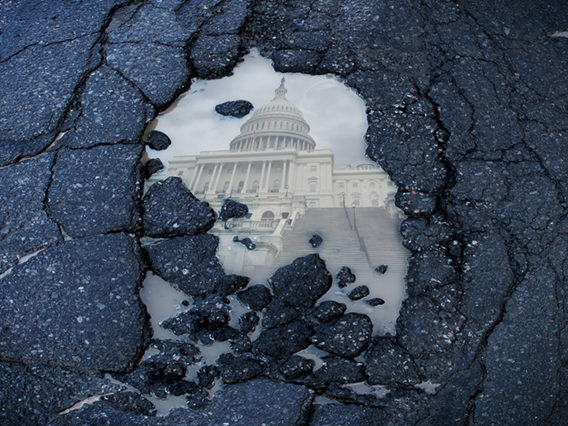
An Agenda for the New Congress
Published on February 17, 2019 / Leer en español

Director - Washington, D.C. Office
SHARE
Driving in Puerto Rico has its challenges. There’s always the risk of a blowout given the amount and depth of potholes in the streets and highways. Though everyone recognizes the problem, dealing with it is complicated. Typically, the federal and local government share responsibility for road repair and since the cost of replacing every square foot is so expensive, they opt for temporary fixes that take care of the immediate problem. But the potholes eventually reappear, sometimes as deeper, wider craters in the road. To make matters worse, Puerto Rico’s transportation system is designed so that we are dependent on automobiles,so we have to resign ourselves to dodging potholes. to the point we have come to terms with the gaping holes.
Puerto Rico’s public policy functions in a similar manner since the political relationship between the Island and the U.S. has structural deficiencies that impact the island’s financial integrity. In other words, there are “potholes” that are often fixed with temporary solutions, while ignoring the underlying cause. To avoid these temporary fixes, there must be the political will to permanently amend federal laws and regulations. Unfortunately, our history indicates that the shortcomings of a number of important federal programs are dealt with only when Puerto Rico is on the verge of a fiscal cliff and panic begins to spread.
Structural Inequities
After Hurricane Maria, Puerto Rico was provided federal disaster relief, as is typically extended to other jurisdictions after natural disasters. As part of the aid packages, Puerto Rico was provided $4.8 billion for its Medicaid program, $1.27 billion in emergency funds for its nutritional assistance program, and a temporary extension in tax reductions under Section 199 of the U.S. tax code, among other forms of relief. However, Puerto Rico is soon approaching dates when it won’t have the ability to meet all of its needs, and that is mainly due to the differences in the way these programs are applied to Puerto Rico. The island is left with no other option but to return to Congress and repeat the same script. To get out of this rut once and for all, the problems must be addressed at their core. Below are two examples of these structural inequities.
Medicaid
According to ASES, the Health Insurance Administration in Puerto Rico, 1,554,018 individuals are eligible to participate in the Medicaid program. The program cost covered by the federal government, known in policy circles as the FMAP, or Federal Medical Assistance Percentage, is arbitrarily capped by law at 55%, as opposed to how it is calculated for other states. If the FMAP were calculated using the same per capita income formula applied to the states, the FMAP for the island could be as high as 83%. Said differently, the government of Puerto Rico is forced to absorb 45% of the cost of the Medicaid program, rather than the 17% it would pay were it provided equal treatment. Further, the amount of federal funds allocated to cover the FMAP is subject to an annual limit. Which means that when funds are exhausted, the government of Puerto Rico is faced with another dilemma: limit the number of individuals who have health coverage or provide fewer medical services. Over the years, the federal government has provided lifelines to prevent such a scenario, but the fundamental problem with the FMAP still remains.
Nutritional Assistance Program
Another example: In 1982, the federal nutritional assistance program (NAP) replaced the traditional supplemental nutrition assistance program, known as SNAP, as the mechanism for providing food assistance to Puerto Rico. Since then, Puerto Rico has received this benefit through a capped block grant administered by the local government. However, the differences in the program’s structure, and therefore, coverage are quite substantial. For example, the subsidy is provided each year as a maximum allocated amount, so that if some exogenous event occurs —such as a hurricane—that negatively affects the population’s economic well-being, the island is not automatically provided an increase in funds, despite facing increased needs. Thus, Puerto Rico receives fewer federal resources to assist low-income families, as compared with other jurisdictions, even though nearly half of the population lives below the federal poverty line.
A New Agenda
These examples illustrate why the Washington, D.C. office of the Center for a New Economy is advocating a less political agenda, one that is more comprehensive and more focused on Puerto Rico’s economic needs. The report from the Congressional Task Force created under PROMESA provides a good starting point, detailing several public policy proposals. One fundamental component would be to extend the earned income tax credit (EITC). In the U.S., the EITC has been recognized as a powerful tool for encouraging individuals to find jobs and for reducing poverty—perhaps two of the biggest socio-economic challenges faced by Puerto Rico.
This year, Washington will be pushing a new agenda for Puerto Rico, and it is critical that everyone recognizes that the most effective way to help Puerto Rico is by discarding limited, piecemeal solutions and instead consider a broader agenda that remedies structural shortcomings, allowing Puerto Rico to focus its attention on economic growth.
